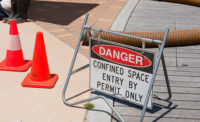2019 top standards- Critical OSHA standards
OSHA confined space general industry standard
29 CFR 1910.146: OSHA Confined Space Standard – General Industry

Date adopted: January 14, 1993
Back story
In January, 1993, OSHA promulgated a standard that requires employers to protect employees assigned to enter Permit-Required Confined Spaces from these hazards. Subsequent revisions clarified several provisions of the rule and revised the "Atmospheric Monitoring" section of non-mandatory Appendix E, "Sewer System Entry."
Scope
The standard applies to all general industry places of employment, including agricultural services, manufacturing, transportation and utilities, wholesale trade, food stores, hotels and other lodging, health services, museums, botanical gardens and zoos.
Confined spaces are large enough for workers to enter and perform certain jobs but have limited or restricted means for entry or exit and are not designed for continuous occupancy. Confined spaces include, but are not limited to, tanks, vessels, silos, storage bins, hoppers, vaults, pits, manholes, tunnels, equipment housings, ductwork, pipelines, etc.
“Permit-required confined spaces" have the potential to contain a hazardous atmosphere; contain material that has the potential to engulf an entrant; or have walls that converge inward or floors that slope downward and taper into a smaller area which could trap or asphyxiate an entrant.
Key hazards
A 1998 incident at Union Carbide Corporation's Taft/Star Manufacturing Plant in Hahnville, Louisiana vividly demonstrated the potential dangers of confined spaces. One worker was killed and another seriously injured when they were asphyxiated by nitrogen. The incident occurred inside a temporary enclosure the workers had erected over the end of large open gas pipe, where they were conducting a black light inspection. The workers were not aware that the pipe was being purged with nitrogen, creating an oxygen-deficient atmosphere.
Key provisions
- Confined spaces that contain or have the potential to contain a serious atmospheric hazard should be classified as permit-required confined spaces, tested prior to entry and continually monitored.
- If a workplace contains permit spaces, the employer must inform exposed employees of their existence, location and the hazards they pose. This can be done by posting danger signs such as “DANGER—PERMIT-REQUIRED CONFINED SPACE—AUTHORIZED ENTRANTS ONLY” or using an equally effective means.
- Any employer who allows employee entry into a permit space must develop and implement a written program to prevent unauthorized entry; identify and evaluate permit space hazards before allowing employee entry; test atmospheric conditions in the permit space before entry operations and monitor the space during entry and establish and implement the means, procedures and practices to eliminate or control hazards necessary for safe permit space entry operations.
- Controlling hazards can include: specifying acceptable entry conditions; isolating the permit space; providing barriers; verifying acceptable entry conditions; and purging, making inert, flushing or ventilating the permit space. In addition to personal protective equipment, other equipment that employees may require for safe entry into a permit space includes: testing, monitoring, ventilating, communications and lighting equipment; barriers and shields; ladders; and retrieval devices.
- If hazardous conditions are detected during entry, employees must immediately leave the space. The employer must evaluate the space to determine the cause of the hazardous atmosphere and modify the program as necessary.
- Before the initial work assignment begins, the employer must provide proper training for all workers who are required to work in permit spaces
- Employers must provide rescue service personnel with personal protective and rescue equipment, including respirators, and training in how to use it. Rescue service personnel also must receive the authorized entrants training and be trained to perform assigned rescue duties and be trained in first aid and CPR.
- Authorized entrants who enter a permit space must wear a chest or full body harness with a retrieval line attached to the center of their backs near shoulder level or above their heads.
Compliance assistance
- “Permit-Required Confined Spaces in General Industry” – an OSHA Quick Card.
- OSHA’s “Confined or Enclosed Spaces and Other Dangerous Atmospheres.”
- OSHA’s “Confined Spaces Advisor.”
Looking for a reprint of this article?
From high-res PDFs to custom plaques, order your copy today!









